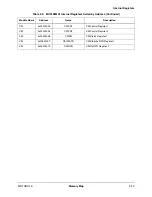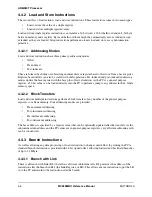
Four Classes of Instructions
MOTOROLA
ARM920T Processor
4-5
•
A bit to indicate ARM9 or Thumb execution
•
Five bits to encode the current processor mode.
All five exception modes also have a Saved Program Status Register (SPSR) that holds the CPSR of the
task immediately before the exception occurred.
4.3.4 Exception Types
ARM9TDMI core supports five types of exception, and a privileged processing mode for each type. The
types of exceptions are:
•
Fast interrupt (FIQ)
•
Normal interrupt (IRQ)
•
Memory aborts (used to implement memory protection or virtual memory)
•
Attempted execution of an undefined instruction
•
Software interrupts (SWIs).
4.3.5 Conditional Execution
All ARM9 instructions (with the exception of BLX) are conditionally executed. Instructions optionally
update the four condition code flags (Negative, Zero, Carry, and Overflow) according to their result.
Subsequent instructions are conditionally executed according to the status of flags. Fifteen conditions are
implemented.
4.4 Four Classes of Instructions
The ARM9 and Thumb instruction sets can be divided into four broad classes of instruction:
•
Data processing instructions
•
Load and store instructions
•
Branch instructions
•
Coprocessor instructions.
4.4.1 Data Processing Instructions
The data processing instructions operate on data held in general purpose registers. Of the two source
operands, one is always a register. The other has two basic forms:
•
An immediate value
•
A register value optionally shifted
If the operand is a shifted register, the shift amount might have an immediate value or the value of another
register. Four types of shift can be specified. Most data processing instructions can perform a shift
followed by a logical or arithmetic operation. Multiply instructions come in two classes:
•
Normal, 32-bit result
•
Long, 32-bit result variants.
Both types of multiply instruction can optionally perform an accumulate operation.
Summary of Contents for DragonBall MC9328MX1
Page 68: ...1 12 MC9328MX1 Reference Manual MOTOROLA Introduction ...
Page 86: ...2 18 MC9328MX1 Reference Manual MOTOROLA Signal Descriptions and Pin Assignments ...
Page 116: ...3 30 MC9328MX1 Reference Manual MOTOROLA Memory Map ...
Page 126: ...4 10 MC9328MX1 Reference Manual MOTOROLA ARM920T Processor ...
Page 160: ...8 8 MC9328MX1 Reference Manual MOTOROLA System Control ...
Page 272: ...13 32 MC9328MX1 Reference Manual MOTOROLA DMA Controller ...
Page 281: ...Programming Model MOTOROLA Watchdog Timer Module 14 9 ...
Page 282: ...14 10 MC9328MX1 Reference Manual MOTOROLA Watchdog Timer Module ...
Page 300: ...15 18 MC9328MX1 Reference Manual MOTOROLA Analog Signal Processor ASP ...
Page 438: ...18 16 MC9328MX1 Reference Manual MOTOROLA Serial Peripheral Interface Modules SPI 1 and SPI 2 ...
Page 478: ...19 40 MC9328MX1 Reference Manual MOTOROLA LCD Controller ...
Page 574: ...21 32 MC9328MX1 Reference Manual MOTOROLA Memory Stick Host Controller MSHC Module ...
Page 598: ...23 16 MC9328MX1 Reference Manual MOTOROLA Real Time Clock RTC ...
Page 670: ...24 72 MC9328MX1 Reference Manual MOTOROLA SDRAM Memory Controller ...
Page 726: ...25 56 MC9328MX1 Reference Manual MOTOROLA SmartCard Interface Module SIM ...
Page 736: ...26 10 MC9328MX1 Reference Manual MOTOROLA General Purpose Timers ...
Page 854: ...29 18 MC9328MX1 Reference Manual MOTOROLA I2C Module ...
Page 900: ...30 46 MC9328MX1 Reference Manual MOTOROLA Synchronous Serial Interface SSI ...
Page 942: ...32 26 MC9328MX1 Reference Manual MOTOROLA GPIO Module and I O Multiplexer IOMUX ...
















































